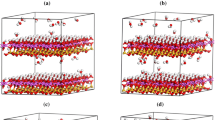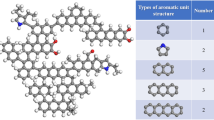Abstract
The formation of gas hydrate is a serious threat to the safe and effective completion of deepwater drilling and transportation operations, although it is considered as a potential energy resource. The inorganic salts are generally used as thermodynamic inhibitors; CaCl2 as a common additive in drilling fluids exhibits unique properties. In this study, we explored the dissociation mechanism of CH4 hydrate in CaCl2 solutions at the macroscopic and microscopic scale using experiment and molecular dynamics (MD) simulation. The experimental results showed that CaCl2 accelerated the dissociation rate of CH4 hydrate. The dissociation rate of CH4 hydrate increased with the increase of CaCl2 concentration at large depressurization pressure and was mainly affected by pressure when the depressurization pressure was lower. MD simulations were used to give an atomic scale interpretation of the macroscopic results obtained from the experiment. The results showed that the addition of CaCl2 destroyed the resistance liquid film formed during CH4 hydrate dissociation, thus accelerating the dissociation process, in good agreement with experimental results.
Highlights
• The amount of CaCl2 affects CH4 hydrate dissociation at large depressurization pressure.
• The dissociation of CH4 hydrate at low depressurization pressure is dependent on pressure.
• Ca2+ destroys effectively the resistance liquid film produced during hydrate dissociation.
• MD simulation results are in agreement with those of the experiment.









Similar content being viewed by others
Data availability
All data generated or analyzed during this study are included in this manuscript. More data are available from the corresponding author on reasonable request.
Code availability
N/A.
References
Sloan ED (2003) Fundamental principles and applications of natural gas hydrates. Nature 426:353–359. https://doi.org/10.1038/nature02135
Xu J, Gu T, Sun Z et al (2016) Molecular dynamics study on the dissociation of methane hydrate via inorganic salts. Mol Phys. https://doi.org/10.1080/00268976.2015.1081708
Pallipurath MI (2009) Dissociation and subsidence of hydrated sediment: coupled models. Energy Explor Exploit 27:105–131. https://doi.org/10.1260/0144-5987.27.2.105
Grigg RB, Lynes GL (1992) Oil-based drilling mud as a gas-hydrates inhibitor. SPE Drill Eng 7:32–38. https://doi.org/10.2118/19560-PA
Atik Z, Windmeier C, Oellrich LR (2006) Experimental gas hydrate dissociation pressures for pure methane in aqueous solutions of MgCl2 and CaCl2 and for a (methane + ethane) gas mixture in an aqueous solution of (NaCl + MgCl2). J Chem Eng Data. https://doi.org/10.1021/je060225a
Sira JH, Patil SL, Kamath VA (1990) Study of hydrate dissociation by methanol and glycol injection. Proc - SPE Annu Tech Conf Exhib Pi: 977–984. https://doi.org/10.2523/20770-ms
Yu L, Xu Y, Gong Z et al (2018) Experimental study and numerical modeling of methane hydrate dissociation and gas invasion during drilling through hydrate bearing formations. J Pet Sci Eng 168:507–520. https://doi.org/10.1016/j.petrol.2018.05.046
Xu J, Chen Z, Liu J et al (2017) A molecular dynamic study on the dissociation mechanism of SI methane hydrate in inorganic salt aqueous solutions. J Mol Graph Model 75:403–412. https://doi.org/10.1016/j.jmgm.2017.03.022
Bagherzadeh SA, Alavi S, Ripmeester JA, Englezos P (2013) Evolution of methane during gas hydrate dissociation. Fluid Phase Equilib 358:114–120. https://doi.org/10.1016/j.fluid.2013.08.017
Tavasoli H, Feyzi F, Dehghani MR, Alavi F (2011) Prediction of gas hydrate formation condition in the presence of thermodynamic inhibitors with the Elliott-Suresh-Donohue Equation of State. J Pet Sci Eng 77:93–103. https://doi.org/10.1016/j.petrol.2011.02.002
Mohammadi AH, Richon D (2012) Phase equilibria of propane and ethane simple hydrates in the presence of methanol or ethylene glycol aqueous solutions. Ind Eng Chem Res. https://doi.org/10.1021/ie201330e
Bai D, Zhang X, Chen G, Wang W (2012) Replacement mechanism of methane hydrate with carbon dioxide from microsecond molecular dynamics simulations. Energy Environ Sci. https://doi.org/10.1039/c2ee21189k
Komatsu H, Ota M, Smith RL, Inomata H (2013) Review of CO2-CH4 clathrate hydrate replacement reaction laboratory studies - properties and kinetics. J Taiwan Inst Chem Eng 44:517–537
Huo Z, Freer E, Lamar M et al (2001) Hydrate plug prevention by anti-agglomeration. Chem Eng Sci 56:4979–4991. https://doi.org/10.1016/S0009-2509(01)00188-9
Hu Y, Makogon TY, Karanjkar P et al (2018) Gas hydrates phase equilibria for structure I and II hydrates with chloride salts at high salt concentrations and up to 200 MPa. J Chem Thermodyn 117:27–32. https://doi.org/10.1016/j.jct.2017.06.007
Lederhos JP, Long JP, Sum A et al (1996) Effective kinetic inhibitors for natural gas hydrates. Chem Eng Sci 51:1221–1229. https://doi.org/10.1016/0009-2509(95)00370-3
Li XY, Wang Y, Sen LX et al (2019) Experimental study of methane hydrate dissociation in porous media with different thermal conductivities. Int J Heat Mass Transf 144:118528. https://doi.org/10.1016/j.ijheatmasstransfer.2019.118528
Song GC, Li YX, Wang WC et al (2017) Experimental study of hydrate dissociation in oil-dominated systems using a high-pressure visual cell. J Nat Gas Sci Eng 45:26–37. https://doi.org/10.1016/j.jngse.2017.04.032
Li S, Wang Z, Xu X et al (2017) Experimental study on dissociation of hydrate reservoirs with different saturations by hot brine injection. J Nat Gas Sci Eng 46:555–562. https://doi.org/10.1016/j.jngse.2017.07.032
Li B, Liu SD, Liang YP (2017) Experimental study of methane hydrate dissociation by depressurization and electrical heating. Energy Procedia 105:5018–5025. https://doi.org/10.1016/j.egypro.2017.03.1006
Kharrat M, Dalmazzone D (2003) Experimental determination of stability conditions of methane hydrate in aqueous calcium chloride solutions using high pressure differential scanning calorimetry. J Chem Thermodyn 35:1489–1505. https://doi.org/10.1016/S0021-9614(03)00121-6
Ke W, Kelland MA (2016) Kinetic hydrate inhibitor studies for gas hydrate systems: a review of experimental equipment and test methods. Energy Fuels 30:10015–10028. https://doi.org/10.1021/acs.energyfuels.6b02739
Inoue R, Tanaka H, Nakanishi K (1996) Molecular dynamics simulation study of the anomalous thermal conductivity of clathrate hydrates. J Chem Phys 104:9569–9577. https://doi.org/10.1063/1.471705
O’Connell ST, Thompson PA (1995) Molecular dynamics-continuum hybrid computations: a tool for studying complex fluid flows. Phys Rev E 52:5792–5795. https://doi.org/10.1103/PhysRevE.52.R5792
Anderson BJ, Tester JW, Borghi GP, Trout BL (2005) Properties of inhibitors of methane hydrate formation via molecular dynamics simulations. J Am Chem Soc. https://doi.org/10.1021/ja0554965
Xu T, Lang X, Fan S et al (2019) The effect of electric fields in methane hydrate growth and dissociation: a molecular dynamics simulation. Comput Theor Chem 1149:57–68. https://doi.org/10.1016/j.comptc.2018.12.018
Xu J, Gu T, Sun Z et al (2016) Molecular dynamics study on the dissociation of methane hydrate via inorganic salts. Mol Phys 114:34–43. https://doi.org/10.1080/00268976.2015.1081708
Cygan RT, Liang J-J, Kalinichev AG (2004) Molecular models of hydroxide, oxyhydroxide, and clay phases and the development of a general force field. J Phys Chem B 108:1255–1266. https://doi.org/10.1021/jp0363287
Kosakowski G, Churakov SV, Thoenen T (2008) Diffusion of Na and Cs in montmorillonite. Clays Clay Miner. https://doi.org/10.1346/CCMN.2008.0560205
Xu J, Camara M, Liu J et al (2017) Molecular dynamics study of the swelling patterns of Na/Cs-, Na/Mg-montmorillonites and hydration of interlayer cations. Mol Simul. https://doi.org/10.1080/08927022.2016.1274982
Camara M, Liao H, Xu J et al (2019) Molecular dynamics study of the intercalation and conformational transition of poly (N-vinyl caprolactam), a thermosensitive polymer in hydrated Na-montmorillonite. Polymer (Guildf). https://doi.org/10.1016/j.polymer.2019.121718
Lu H, Tsuji Y, Ripmeester JA (2007) Stabilization of methane hydrate by pressurization with He or N2 Gas. J Phys Chem B 111:14163–14168. https://doi.org/10.1021/jp076858t
Acknowledgements
This work was supported by the National Natural Science Foundation of China (51874343, U1762212, 51874332, 51874342), Natural Science Foundation of Shan Dong Province (ZR2017MEE027), the Graduate Innovation Foundation of China University of Petroleum (YCX2019012), “PCSIRT” (IRT_14R58), and Shandong Provincial Key Laboratory of Oilfield Chemistry.
Funding
National Natural Science Foundation of China (51874343, U1762212, 51874332, 51874342), Natural Science Foundation of Shan Dong Province (ZR2017MEE027), the Graduate Innovation Foundation of China University of Petroleum (YCX2019012), “PCSIRT” (IRT_14R58), and Shandong Provincial Key Laboratory of Oilfield Chemistry.
Author information
Authors and Affiliations
Contributions
Tingji Ding, Ruihe Wang, Jiafang Xu, Moussa Camara, Weidong Zhou, and Jun Zhang designed the research; Tingji Ding, Jiafang Xu, Moussa Camara, and Jun Zhang performed the research; Tingji Ding, Ruihe Wang, Jiafang Xu, Moussa Camara, Weidong Zhou, and Jun Zhang analyzed the data; Tingji Ding, Ruihe Wang, Jiafang Xu, and Moussa Camara wrote the paper.
Corresponding authors
Ethics declarations
Ethics approval
N/A.
Consent to participate
N/A.
Consent for publication
Written informed consent for publication was obtained from all participants.
Competing interests
The authors declare no competing interests.
Additional information
Publisher's note
Springer Nature remains neutral with regard to jurisdictional claims in published maps and institutional affiliations.
Rights and permissions
About this article
Cite this article
Ding, T., Wang, R., Xu, J. et al. Dissociation mechanism of methane hydrate by CaCl2: an experimental and molecular dynamics study. J Mol Model 28, 109 (2022). https://doi.org/10.1007/s00894-022-05070-6
Received:
Accepted:
Published:
DOI: https://doi.org/10.1007/s00894-022-05070-6




